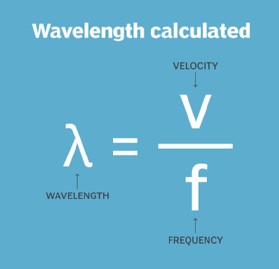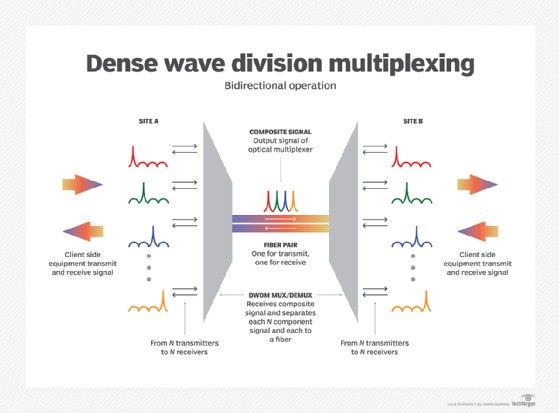What Is A Wavelength? It’s a fundamental concept in physics, representing the spatial period of a wave. At WHAT.EDU.VN, we aim to demystify scientific concepts, offering clear explanations and fostering understanding of waves, electromagnetic spectrum, and wave properties. Dive in to explore the wave characteristic and how it impacts various phenomena around us.
1. Defining Wavelength: A Comprehensive Overview
Wavelength is the distance between identical points (adjacent crests) in the adjacent cycles of a waveform signal propagated in space or along a wire. Understanding wavelength is crucial because it helps us describe and analyze waves, whether they are sound waves, light waves, or any other form of electromagnetic radiation. It’s an essential concept in fields like physics, engineering, and telecommunications.
In simpler terms, imagine a wave moving through water. The wavelength would be the distance from the top of one wave (crest) to the top of the next wave. This measurement provides valuable information about the wave’s characteristics and behavior.
1.1 Wavelength in Different Systems
Wavelength specifications vary depending on the system:
-
Wireless systems: Typically measured in meters (m), centimeters (cm), or millimeters (mm).
-
Infrared (IR), visible light, ultraviolet (UV), and gamma radiation (γ): Often specified in nanometers (nm) or angstroms (Å).
- Nanometers: Units of 10-9 m
- Angstroms: Units of 10-10 m
1.2 The Inverse Relationship: Wavelength and Frequency
Wavelength has an inverse relationship with frequency. Frequency refers to the number of wave cycles per second. This means that as the frequency of a signal increases, the wavelength decreases, and vice versa. This relationship is a cornerstone in understanding wave behavior.
Imagine tuning a radio. When you increase the frequency, you are effectively shortening the wavelength that the radio receiver is capturing. This principle is used extensively in radio communications, telecommunications, and other technologies.
1.3 Examples of Waves
- Sound Wave: The pattern of disturbance caused by the movement of energy traveling through a medium (air, water, or any other liquid or solid matter) as it propagates away from the source of the sound.
- Water Wave: A wave that involves a combination of longitudinal and transverse motions.
- Electromagnetic Wave: Vibrations between an electric field and a magnetic field. This type of wave includes light, radio waves, and X-rays.
2. How to Measure Wavelength Accurately
Measuring wavelength requires specialized instruments and techniques tailored to the specific type of wave being analyzed. The accuracy of these measurements is essential for various applications, including scientific research, telecommunications, and medical diagnostics.
2.1 Instruments for Wavelength Detection
Instruments such as optical spectrometers or optical spectrum analyzers can detect wavelengths in the electromagnetic spectrum. These tools are essential for scientists and engineers working with light, radio waves, and other forms of electromagnetic radiation.
An optical spectrometer works by separating light into its constituent wavelengths and measuring the intensity of each wavelength. This allows researchers to identify the specific wavelengths present in a light source, which can provide valuable information about the source’s properties. Spectrum analyzers perform similar functions for radio waves and other electromagnetic signals.
2.2 Units of Measurement for Wavelength
Wavelengths are typically measured in the following units:
- Kilometers (km)
- Meters (m)
- Millimeters (mm)
- Micrometers (μm)
- Nanometers (nm)
- Picometers (pm)
- Femtometers (fm)
The choice of unit depends on the scale of the wavelength being measured. For instance, radio waves have much longer wavelengths, often measured in meters or kilometers, while gamma rays have extremely short wavelengths, typically measured in picometers or femtometers.
2.3 Measuring Wavelengths on the Electromagnetic Spectrum
The distance between repetitions in the waves indicates where the wavelength is on the electromagnetic radiation spectrum. This spectrum includes radio waves in the audio range and waves in the visible light range. Different regions of the electromagnetic spectrum have different properties and are used for various applications.
For example, radio waves are used for communication, microwaves are used for cooking and telecommunications, infrared radiation is used for thermal imaging, visible light is used for vision, ultraviolet radiation is used for sterilization, X-rays are used for medical imaging, and gamma rays are used for cancer treatment.
3. Understanding the Wavelength Formula
The wavelength formula is a fundamental equation that relates wavelength to wave velocity and frequency. This formula is essential for calculating wavelength in various applications, including telecommunications, acoustics, and optics.
3.1 The Basic Wavelength Equation
Divide the velocity of a wave by its frequency to calculate wavelength. This is often expressed as the equation:
λ = v / f
Where:
- λ (lambda) represents wavelength, expressed in meters.
- v is wave velocity, calculated as meters per second (m/s).
- f stands for frequency, which is measured in hertz (Hz).
This equation allows you to determine the wavelength of a wave if you know its velocity and frequency. Conversely, you can also calculate the frequency if you know the wavelength and velocity.
3.2 Practical Examples of Wavelength Calculation
For example, if f is the frequency of the signal as measured in megahertz (MHz), and λ is the wavelength as measured in meters, then:
- λ = 300 / f
- f = 300 / λ
These simplified formulas are commonly used in telecommunications to quickly estimate wavelength and frequency in radio wave applications.
3.3 Real-World Applications of the Formula
The wavelength formula has numerous real-world applications:
- Telecommunications: Engineers use it to design antennas and communication systems.
- Medical Imaging: Doctors use it to interpret MRI and X-ray images.
- Astronomy: Astronomers use it to analyze light from distant stars and galaxies.
- Music: Sound engineers use the relationship to calculate resonance and acoustic properties.
4. Wave Division Multiplexing: Harnessing Wavelengths
Wave division multiplexing (WDM) is a technology that significantly increases the capacity of fiber optic cables by allowing multiple signals to be transmitted simultaneously over a single fiber. This technology has revolutionized telecommunications, enabling faster and more efficient data transmission.
4.1 The Evolution of Fiber Optic Technology
In the 1990s, fiber optic cable’s ability to carry data was significantly increased with the development of wavelength-division multiplexing (WDM). AT&T’s Bell Labs introduced this technique, which established a way to split a beam of light into different wavelengths that could travel through the fiber independent of one another. These optical networks are also called photonic networks because they use light to transmit data.
WDM works by assigning different wavelengths of light to different data channels. This allows multiple signals to be transmitted simultaneously over a single fiber, greatly increasing the cable’s capacity.
4.2 WDM and DWDM: Enhancing Optical Networks
WDM, along with dense WDM (DWDM) and other methods, permits a single optical fiber to transmit multiple signals at the same time. As a result, existing optical networks gain increased capacity. DWDM is an advanced form of WDM that uses even more closely spaced wavelengths, allowing for even greater capacity.
These technologies are essential for modern telecommunications networks, which need to transmit vast amounts of data quickly and efficiently.
4.3 Common Wavelengths in Fiber Optics
The three most common wavelengths in fiber optics are 850 nm, 1,300 nm, and 1,550 nm. These wavelengths are chosen because they have low attenuation in fiber optic cables, allowing signals to travel long distances with minimal loss.
- 850 nm: Commonly used for short-distance communication.
- 1,300 nm: Used for medium-distance communication.
- 1,550 nm: Used for long-distance communication.
5. Exploring Different Types of Waveforms
A waveform describes the shape or form of a wave signal. Wave is typically used to describe an acoustic signal or cyclical electromagnetic signal because each is similar to waves in a body of water. Understanding different types of waveforms is essential for analyzing and manipulating signals in various fields, including electronics, telecommunications, and acoustics.
5.1 Four Basic Types of Waveforms
-
Sine Wave: The voltage increases and decreases in a steady curve. Sound waves, light waves, and water waves all have sine waves. Additionally, the alternating current voltage provided in the public power grid is in the form of a sine wave.
Sine waves are the purest form of wave and are characterized by their smooth, oscillating pattern. They are used as a fundamental building block for more complex waveforms.
-
Square Wave: The square wave represents a signal where voltage simply turns on, stays on for a while, turns off, stays off for a while, and repeats. It’s called a square wave because the graph of a square wave shows sharp, right-angle turns. Many electronic circuits have square waves.
Square waves are commonly used in digital electronics to represent binary data (0s and 1s).
-
Triangle Wave: The voltage increases in a straight line until it reaches a peak value, and then it decreases in a straight line. If the voltage reaches zero and starts to rise again, the triangle wave is a form of direct current (DC). However, if the voltage crosses zero and goes negative before it starts to rise again, the triangle wave is a form of alternating current (AC).
Triangle waves are used in various electronic circuits, such as oscillators and function generators.
-
Sawtooth Wave: The sawtooth wave is a hybrid of a triangle wave and a square wave. In most sawtooth waves, the voltage increases in a straight line until it reaches its peak voltage, and then the voltage drops instantly — or almost instantly — to zero and repeats immediately.
Sawtooth waves are used in television displays and music synthesizers.
5.2 Characteristics of Each Waveform
Each type of waveform has unique characteristics that make it suitable for different applications. Sine waves are smooth and continuous, square waves are abrupt and digital, triangle waves are linear and ramped, and sawtooth waves are asymmetric and periodic.
Understanding these characteristics is crucial for selecting the appropriate waveform for a specific application.
6. Frequency and Wavelength: An Intertwined Relationship
Wavelength and frequency of light are closely related. The higher the frequency, the shorter the wavelength. The lower the frequency, the longer the wavelength. The energy of a wave is directly proportional to its frequency but inversely proportional to its wavelength. That means the greater the energy, the larger the frequency, and the shorter the wavelength. Given the relationship between wavelength and frequency, short wavelengths are more energetic than long wavelengths.
This relationship is fundamental to understanding the behavior of electromagnetic radiation.
6.1 How Frequency Affects Wavelength
The relationship between frequency and wavelength can be summarized as follows:
- High frequency = Short wavelength = High energy
- Low frequency = Long wavelength = Low energy
This means that waves with short wavelengths, such as gamma rays and X-rays, have high frequencies and carry a lot of energy. Conversely, waves with long wavelengths, such as radio waves, have low frequencies and carry less energy.
6.2 Electromagnetic Waves and Speed
Electromagnetic waves always travel at the same speed: 299,792 kilometers per second (km/s). This speed is commonly referred to as the speed of light. In the electromagnetic spectrum, numerous types of waves exist with different frequencies and wavelengths. However, they’re all related by one equation: The frequency of any electromagnetic wave multiplied by its wavelength equals the speed of light.
This constant speed is a fundamental property of electromagnetic radiation and is used in various calculations and applications.
6.3 Examples of Energy and Wavelength
Consider the following examples:
- Gamma Rays: Extremely short wavelengths, very high frequency, and very high energy. Used in cancer treatment.
- X-Rays: Short wavelengths, high frequency, and high energy. Used in medical imaging.
- Visible Light: Wavelengths range from 400 nm (violet) to 700 nm (red). Frequencies and energies vary accordingly. Used for vision.
- Radio Waves: Long wavelengths, low frequency, and low energy. Used for communication.
7. Wavelengths in Wireless Networks: Practical Implications
Although frequencies are more commonly discussed in wireless networking, wavelengths are also an important factor in Wi-Fi networks. Wi-Fi operates at six frequencies, all in the gigahertz range: 2.4 GHz, 3.6 GHz, 4.9 GHz, 5 GHz, 5.9 GHz, and 6 GHz. Higher frequencies have shorter wavelengths, and signals with shorter wavelengths have more trouble penetrating obstacles like walls and floors.
This means that the choice of frequency in a wireless network can have a significant impact on its performance.
7.1 The Impact of Wavelength on Signal Penetration
As a result, wireless access points that operate at higher frequencies — with shorter wavelengths — often consume more power to transmit data at similar speeds and distances achieved by devices that operate at lower frequencies — with longer wavelengths. Shorter wavelengths are more easily absorbed or reflected by obstacles, which can reduce the range and coverage of a wireless network.
For example, a 2.4 GHz signal (longer wavelength) can penetrate walls and floors more easily than a 5 GHz signal (shorter wavelength). This is why 2.4 GHz is often preferred for applications where coverage is more important than speed.
7.2 Optimizing Wireless Network Performance
To optimize wireless network performance, it is important to consider the trade-offs between frequency, wavelength, and signal penetration. In general, lower frequencies are better for coverage, while higher frequencies are better for speed.
- 2.4 GHz: Better coverage, lower speed.
- 5 GHz: Shorter range, higher speed.
7.3 Future Trends in Wireless Technology
As wireless technology continues to evolve, new frequencies and techniques are being developed to improve network performance. For example, the use of millimeter waves (very short wavelengths) is being explored for 5G networks, which can provide very high speeds but have limited range and penetration.
8. FAQ: Wavelength Demystified
| Question | Answer |
|---|---|
| What exactly is wavelength? | Wavelength is the distance between identical points (such as adjacent crests) in the consecutive cycles of a wave. It’s a spatial measure, usually in meters, centimeters, or nanometers, representing one full cycle of a wave. |
| How is wavelength related to frequency? | Wavelength and frequency are inversely related. As frequency increases, wavelength decreases, and vice versa. Their relationship is defined by the formula: wavelength = wave speed / frequency. |
| Can you give examples of different types of waves? | Sure! Examples include sound waves (mechanical waves that need a medium), light waves (electromagnetic waves that can travel through a vacuum), water waves, and radio waves. |
| What instruments are used to measure wavelength? | Instruments like spectrometers and optical spectrum analyzers are used to measure wavelengths in the electromagnetic spectrum. For sound waves, microphones connected to oscilloscopes can measure the wavelengths. |
| Why is wavelength important in wireless communication? | Wavelength affects how signals propagate, especially in relation to obstacles. Shorter wavelengths (higher frequencies) are more easily blocked by walls, while longer wavelengths (lower frequencies) can penetrate better. |
| How does wavelength affect the color of light? | The color of light is directly related to its wavelength. Different wavelengths correspond to different colors; for example, shorter wavelengths are seen as violet and blue, while longer wavelengths appear as red. |
| What is the significance of wavelength in fiber optics? | In fiber optics, different wavelengths are used to transmit multiple signals simultaneously through a single fiber using a technique called wavelength-division multiplexing (WDM), enhancing the capacity of data transmission. |
| How do different mediums affect wavelength? | The speed of a wave changes depending on the medium it travels through, which in turn affects its wavelength. Since wavelength is wave speed divided by frequency, a slower speed results in a shorter wavelength if frequency is constant. |
| Why are shorter wavelengths more energetic? | The energy of a wave is inversely proportional to its wavelength. Shorter wavelengths have higher frequencies, and higher frequencies mean more energy according to the equation E = hf, where E is energy, h is Planck’s constant, and f is frequency. |
| How is wavelength used in medical applications? | In medical applications, wavelengths are used in imaging technologies such as X-rays and MRI. Different wavelengths can penetrate different tissues, allowing doctors to visualize internal structures without surgery. |



9. Uncover More with WHAT.EDU.VN
Still have questions about wavelength or other scientific concepts? Don’t struggle in silence. At WHAT.EDU.VN, we provide a free and easy platform to ask any question you have and receive quick, accurate answers from knowledgeable experts.
9.1 Why Choose WHAT.EDU.VN?
- Free Access: Ask any question without any cost.
- Fast Responses: Get your answers quickly.
- Expert Advice: Connect with knowledgeable professionals.
- Easy to Use: Simple and intuitive platform.
- Comprehensive Coverage: Get answers covering all topics and subjects.
9.2 Get Started Today
Don’t let your questions go unanswered. Join the WHAT.EDU.VN community today and get the clarity you deserve. Whether it’s a simple question or a complex problem, we’re here to help.
9.3 Contact Us
Have questions or need assistance? Contact us today.
- Address: 888 Question City Plaza, Seattle, WA 98101, United States
- WhatsApp: +1 (206) 555-7890
- Website: WHAT.EDU.VN
Unlock a world of knowledge and get the answers you need at what.edu.vn. Ask your question now!
